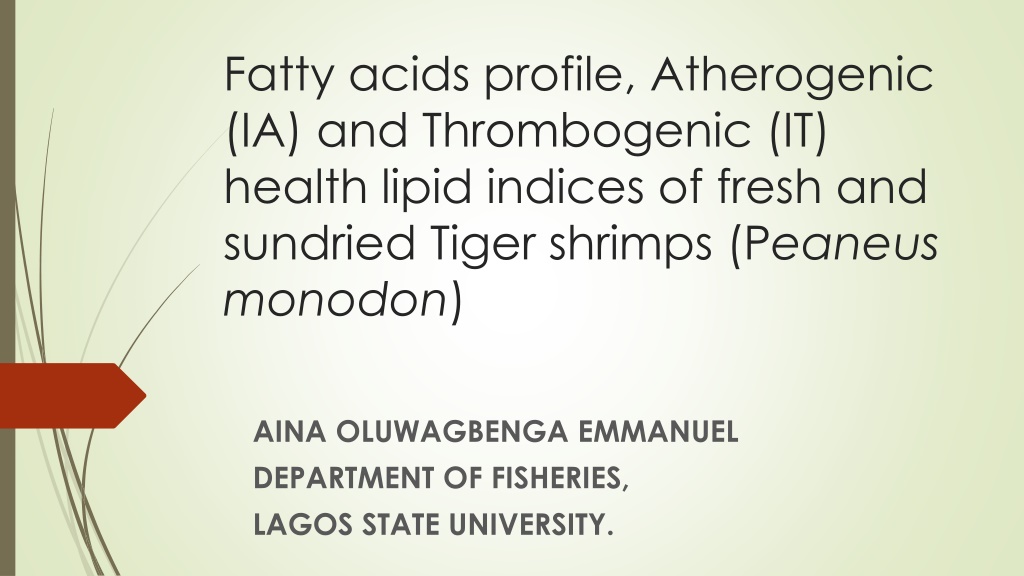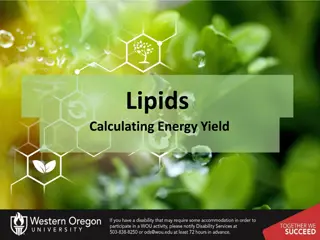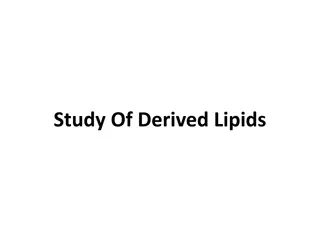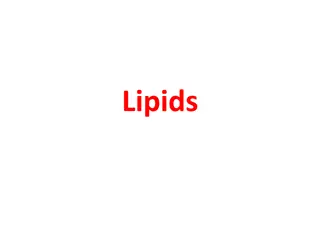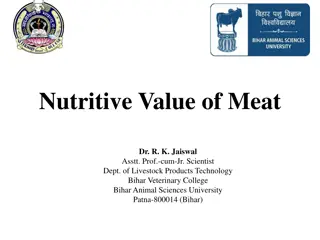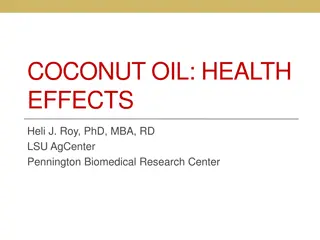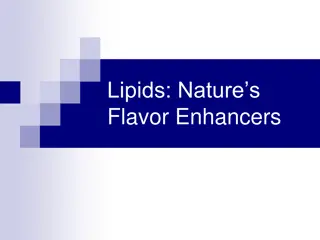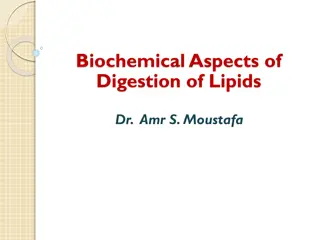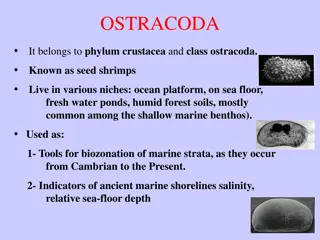Fatty Acids Profile and Health Lipid Indices of Tiger Shrimps
Seafood lipids, including Tiger shrimps like Peaneus monodon, are rich in essential fatty acids such as EPA, DHA, and AA. This study focuses on the fatty acids profile, atherogenic (IA), and thrombogenic (IT) health lipid indices of fresh and sundried Tiger shrimps, shedding light on the effects of sundrying on the nutritional value and consumer health. The research aims to provide valuable insights into the quality changes post-sundrying and the overall nutritional significance of Tiger shrimps in our diets, emphasizing their potential protective effects against cardiovascular diseases.
Download Presentation

Please find below an Image/Link to download the presentation.
The content on the website is provided AS IS for your information and personal use only. It may not be sold, licensed, or shared on other websites without obtaining consent from the author. Download presentation by click this link. If you encounter any issues during the download, it is possible that the publisher has removed the file from their server.
E N D
Presentation Transcript
Fatty acids profile, Atherogenic (IA) and Thrombogenic (IT) health lipid indices of fresh and sundried Tiger shrimps (Peaneus monodon) AINA OLUWAGBENGA EMMANUEL DEPARTMENT OF FISHERIES, LAGOS STATE UNIVERSITY.
TABLE OF CONTENT INTRODUCTION AIMS OF THE RESEARCH MATERIALS AND METHODS RESULTS CONCLUSIONS
INTRODUCTION Sea food lipids have been intensely investigated due to the fact that their protective effects on cardiovascular diseases is of great concern in the nutrition world. Peaneus monodon, among many other invertebrates, are considered to be important shell fishery products (G koolu and Yerlikaya, 2003), and are widely used as food and feed supplements throughout the world. Fatty acids, such as eicosapentanoic acid (EPA), docosahexanoic acid (DHA) and arachidonic acid (AA) which are considered essential for human and must be provided in the diet, are highly concentrated in Tiger shrimps (Alvarez, 2006). Despite the vast Tiger shrimp s diversity and popularity of sundrying as a method of preservation, there is a lack of data on fatty acid composition and health lipid indices of sundried Tiger shrimp (Mai et al., 1978).
INTRODUCTION (contd.) Ross arteriosclerotic vascular disease or ASVD) as a specific form of condition in which an arterial wall thickens as a result of accumulation of calcium and fatty materials such as cholesterol and tryglicerides. It reduces the elasticity of the arterial wall and therefore allows less blood to travel through. This also increases blood pressure. and Russel, (1993) referred to atherosclerosis (also known as Index of Atherogenicity (IA) is a value that determines the ability of a particular ingested food substance to cause atherosclerosis.
INTRODUCTION (contd.) Thrombogenesis refers to the condition in which a material come in contact with the blood to produce a thrombus, or a blood clot, through a process called thrombosis. The blood clot, formed inside a blood vessel, obstructs the flow of blood through the circulatory system (arterial walls) thereby increasing the risk of Cardiovascular Diseases (CVD). Index of Thrombogenicity (IT) is a value that determines the ability of a particular ingested food substance to cause thrombosis.
AIMS OF THE RESEARCH 1. This study was designed to further determine the fatty acids value of Peaneus monodon. 2. This study was also designed to evaluate the effects of sundrying of Peaneus monodon on health of consumers. 3. It was arranged to underscore the changes in quality of Peaneus monodon after sundrying. 4. This research was carried out to provide useful information on health and nutritional values of this delicacy, considering its importance in our diets.
MATERIALS AND METHODS SAMPLES COLLECTION Penaeus monodon weighing 58.40 70.44g were collected from shrimpers, Apapa, Lagos. The trawlers fishing ground was FAO zone 34,100 nautical miles of the Nigerian coast. Shrimp samples immediately in a plastic ice box which was later transported to the Laboratory for processing and analysis. collected were deeply iced
MATERIALS AND METHODS (contd.) INDICES OF LIPID QUALITY From the fatty-acid composition data, the following were calculated: Index of Atherogenicity (IA): indicating the relationship between the sum of the main saturated fatty acids and that of the main classes of unsaturated fatty acids [Ulbritch and Southgate, (1991)].
The following equation was applied: Index of Atherogenicity (IA) = [(4 * C16:0) + C17:0 + C18:0] MUFA + PUFA 6 + PUFA 3
MATERIALS AND METHODS (contd.) Index of Thrombogenicity (IT): showing the tendency to form clots in the blood vessels (Senso et al., 2007). The following equation was applied: Index of Thrombogenicity (IT) = [C16:0 + C17:0 + C18:0] (0.5*MUFA + 0.5*PUFA 6 + 3*PUFA 3 + (PUFA 3/PUFA 6)
TABLE 1: DISTRIBUTION OF FATTY ACIDS IN FRESH AND SUNDRIED TIGER SHRIMP (P.monodon) (%). FATTY ACIDS FRESH SUNDRIED MEAN S.Da MEAN S.Da SATURATED FATTY ACIDS COMPOSITION (%) Myristic acid methyl ester (C14:0) 0.67 + 0.02 0.62 + 0.04 Palmitic acid methyl ester (C16:0) 15.29 + 0.2 14.78 + 0.26 Margaric acid methyl ester (C17:0) 1.18 + .02* 0.78 + 0.01* Stearic acid methyl ester (C18:0) 11.34 + 0.19* 9.83 + 0.16* Arachidic acid methyl ester (C20:0) 0.27 + 0.07 0.32 + 0.14
TABLE 1: DISTRIBUTION OF FATTY ACIDS IN FRESH AND SUNDRIED TIGER PRAWN (P.monodon) (%) (contd.) MONO-UNSATURATED FATTY ACIDS COMPOSITION (%) Palmitoleic acid methyl ester (C16:1) 3.56 + 0.06 3.79 + 0.14 Oleic acid methyl ester (C18:1) 25.50 + 0.53 26.2 + 0.01 Erucic acid methyl ester (C22:1) 0.03 + 0.01 0.04 + 0.02 MUFA 29.09 + 0.6 30.03 + 0.17 POLYUNSATURATED FATTY ACIDS COMPOSITION (%) Linoleic acid methyl ester (C18:2n-6) 6.57 + 0.16* 5.87 + 0.04* Linolenic acid methyl ester (C18:3n-6) 17.73 + 0.0 17.96 + 0.09 Eicosapentanoic acid (C20:5n-3) 8.65 + 0.23 8.93 + 0.15
TABLE 1: DISTRIBUTION OF FATTY ACIDS IN FRESH AND SUNDRIED TIGER PRAWN (P.monodon) (%) (contd.) Arachidonic acid methyl ester (C20:4n-6) 7.12 + 0.05* 8.15 + 0.13* Docosahexanoic acid methyl ester (C22:6n-3) 1.75 + 0.08* 2.38 + 0.06* PUFA 41.82 + 0.61 43.29 + 0.47 UFA 70.91 + 1.21 73.32 + 0.64 FAME 100 + 1.79 100 + 1.41 6/ 3 3.02 + 0.68 2.83 + 1.23 IA 0.44 + 0.00 0.38 + 0.00 IT 0.23 + 0.00 0.18 + 0.00 a Mean (M) and standard deviation (S.D) of duplicated samples * Signifies MEAN + S.D with significant differences
RESULTS The PUFA was the most abundant representing about 43% of the total fatty acids (TFA) content. A lower concentration of SFA was observed in the sundried samples (compared to fresh forms) with concentration value of 27.53%. PUFA levels including linoleic acid, arachidonic acid, docosahexanoic acid were significantly different (p < 0.05).
RESULTS (contd.) Two distinct indices were investigated: 1) Atherogenic index (IA); and 2) Thrombogenic index (IT). Examining the values reported in thisstudy, it is evident that both atherogenic and thrombogenic indices decreased, and are considered low after the preservation process was carried out
CONCLUSION The study observed that including Peanues monodon in our diets goes a long way in assuring a healthy living for the consumers. Also, sundrying of Peanues monodon before cooking/eating was observed to be a preferable approach to improving our dietary habit compared to freshly caught samples as observed in this study. It also revealed, with the values of IA and IT reported, that eating more of sundried tiger shrimps is less atherogenic and thrombogenic compared to the fresh meal, which then implies that it is advisable to include sundried tiger shrimps in our diets in replace of fresh forms as this could help consumers prevent themselves from risk of various heart related diseases among many other diseases also prevented.
CONCLUSION (contd.) In addition, with the values of PUFA and MUFA, higher than SFA (PUFA>MUFA>SFA), and the values of n-3 and n-3/n-6, which are higher in the sundried samples, it implies that sundried Tiger shrimps are more beneficial compared to fresh Tiger shrimps. Therefore, consumption of sundried Tiger shrimps could offer nutritional advantage to consumers since food products with lower SFA and n6/n3, and higher n-3 fatty acids have hypo-cholesterolemic properties and anti-arrythmic effect which offer health benefits. From the results obtained, it is advisable to consume more of sundried Tiger shrimps in replace of the fresh forms, this is in light of the fact that such food products have been linked to decreased total and LDL-cholesterol levels and consequently reducing the risk of coronary heart disease, CHD, and help improve some other functioning systems in the body such as brain and the retina.
CONCLUSION (contd.) Recent studies {(Ulbritch and Southgate, (1991) Higgs, (2000) and Akintola et al., (2013)} have reported that a lower index of atherogenicity indicates an increase in the ability of the arterial walls to allow free flow of blood, emphasizing the fact that consumption of sundried Tiger shrimps provides an adequate level of n-3 fatty acids whose consumption is very important in regulating and balancing the ratio of HDL/LDL cholesterol in the body system. Also, same studies report lower index of thrombogenicity to have positive effects in controlling and normalizing the clot formation activities in the blood vessels, this ensures preventing humans from various coronary related diseases, and could be related to longevity, as cardiovascular diseases (CVD) have been reported to be high on the list of prominent killer diseases in the world.
